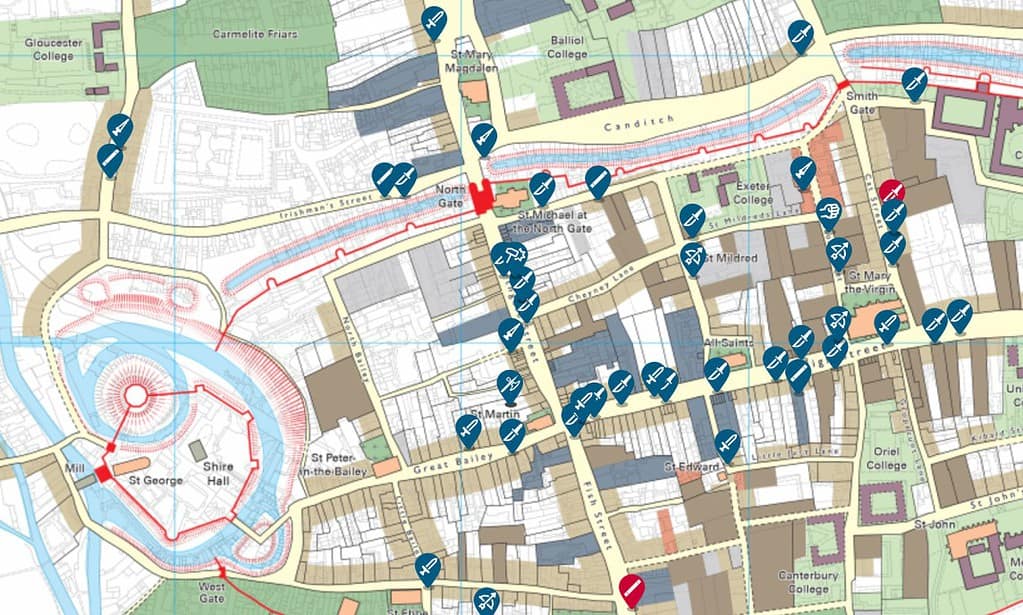Oxford, home to one of the world’s leading universities, used to be the murder capital of late-medieval England, according to a new study. Researchers have mapped medieval England’s known murder cases and found the homicide rate in Oxford was four to five times higher than that of London or York, caused largely by male students.

Medieval Murder Maps is a project by researchers at the University of Cambridge to plot crime scenes based on translated research from 700-year-old coroners’ examinations. Originally launched in 2018, they first focused on London but then expanded it to York and Oxford, cataloging 354 homicide crime scenes in Medieval England.
Of the criminals plotted in Oxford, 75% were identified by the coroner as “clericus,” a term used to describe students or members of the early university. But that’s not all — 72% of the victims were also classified as clericus. All this can be seen on the project website, with details on each of the deaths, explaining where and how they happened.
An unexpected hotspot for violence
“A medieval university city such as Oxford had a deadly mix of conditions,” Manuel Eisner, murder map investigator, said in a news release. Students were all male and aged between 14 and 21, “the peak for violence and risk-taking,” Eisner said. The city had a population of about 7,000 people of which 1,500 are believed to have been students.
These young students didn’t have much social control and lived in an environment with easy access to weapons, alcohol and sex workers, the researchers explained. Many belonged to fraternities called “nations” and this was an additional source of conflict. All these elements came together and created the ideal setting for seeding violence.
In their study, the researchers read (and translated) coroners’ rolls, which recorded suspicious deaths as concluded by a jury of local residents. They included many details of each crime, such as the name of the perpetrator and the victim, the location of the crime scene and the type of weapon used in the homicide. Then they pinned these details to contemporaneous maps of the three cities.
A murder rate x5 that of London’s
Eisner and the team of researchers estimated the homicide rate in late medieval Oxford at 60-67 per 100,000. This is about 50 times higher than current rates in 21st-century English cities (less than 20 murders per million). The researchers believe this was because many young men gathered in the same place with weapons and alcohol readily available.

For example, there was an argument on a Thursday night in 1298 between a group of students in an Oxford High Street tavern that resulted in a mass street fight with swords and axes. The coroner recorded that John Burel, a student, had “a mortal wound on the crown of his head, six inches long and in depth reaching to the brain”.
Many interactions with sex workers also ended tragically when students became violent. One unknown scholar murdered Margery de Hereford in the parish of St. Aldate in 1299, stabbing her to death instead of paying for intercourse. Also, in 1296, a gang of students killed one of their own after bringing back a sex worker to the school.
There were also cases triggered by rifts among scholars from different parts of what is now the United Kingdom. Friction between Irish, Welsh and English students was common. For example, in the spring of 1303, student Adam de Sarum was stabbed in the face and throat by a trio of Irish scholars. He was playing ball in the street and was surprised by them.
For Oxford, information about the (many) killings is well recorded for six years preceding 1348, before the bubonic plague hit the city. Partial Oxford records also exist for 15 years between 1296 and 1324. For London, there’s information for nine years between 1300 and 1340, while for York the researchers covered a period between 1345 and 1385.
“Life in medieval urban centers could be rough, but it was by no means lawless. The community understood their rights and used the law when conflicts emerged. Each case provides a glimpse of the dynamics that created a burst of violence on a street in England some seven centuries ago,” Eisner said in a news release.





